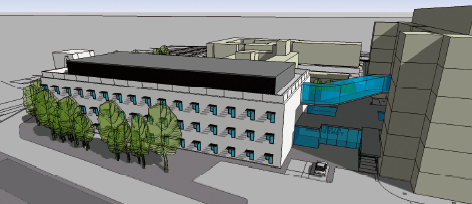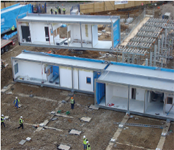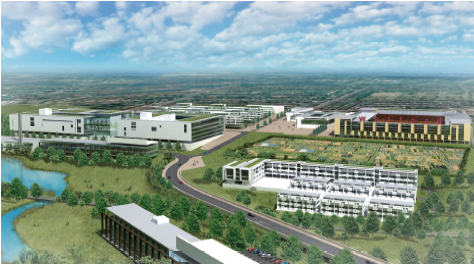Annual Report 2007-2008
Delivering a Healthy Future
In September 2007 the service for patients requiring emergency Orthopaedic treatment centralised in a new Cleves Ward at Watford General Hospital and planned Orthopaedic and day surgery services were brought together in a new Elective Care Centre at St Albans City Hospital. The majority of planned operations now take place at St Albans and helps the Trust organise services much better. Patients can be screened for infection before being admitted for their planned procedure, which significantly helps with the control of infection. Patients also have less chance of their planned operation being cancelled, as there are no emergency cases being admitted which would take precedence over planned procedures.
Although the initial transfer of planned services at St Albans went smoothly, it soon became apparent that, for a number of reasons, the Elective Care Centre was not running as well as the Trust expected. Since then, the Trust has focused hard on getting this service to run efficiently and effectively and it has recently seen a dramatic improvement in its performance.
 2008 kicked off with a bang at Watford General Hospital when Claire Ward, MP for
Watford ‘helped’ the Trust demolish its Postgraduate Medical Centre in order to site a new
Acute Admissions Unit (AAU) adjacent to the existing A&E department. The new ultramodern
120-bed AAU, which is believed to be the largest in the country, will radically
change the way west Hertfordshire patients receive emergency care in the future and
enable the Trust to deal efficiently and effectively with the increase of emergency
admissions when emergency services centralise.
2008 kicked off with a bang at Watford General Hospital when Claire Ward, MP for
Watford ‘helped’ the Trust demolish its Postgraduate Medical Centre in order to site a new
Acute Admissions Unit (AAU) adjacent to the existing A&E department. The new ultramodern
120-bed AAU, which is believed to be the largest in the country, will radically
change the way west Hertfordshire patients receive emergency care in the future and
enable the Trust to deal efficiently and effectively with the increase of emergency
admissions when emergency services centralise.
This new facility will be the 'front door' for the majority of patients requiring emergency treatment and will offer rapid assessment and diagnosis by a senior doctor and early treatment, which can drastically improve the long-term effects of some illnesses, such as heart attack, stroke, etc. The AAU will house two catheterisation laboratories offering treatment for heart attack patients called angioplasty, as well as x-ray, CT and ultrasound facilities and a new hospital pharmacy with robotic dispensing.
 The building was constructed by the Trust’s partner, Medicinq Osborne, using an off-site
modular method. This enabled the 150 modular steel-framed building to be manufactured
in a controlled factory environment while the foundations were laid on site at Watford
General. This method significantly reduced disruption to patients, staff and the local
community during construction, as there were fewer vehicles on site meaning it was safer,
quieter and cleaner. The modules were then craned into position during March and
April 2008 to form the complete building. The new service will be open to patients in
Spring 2009.
The building was constructed by the Trust’s partner, Medicinq Osborne, using an off-site
modular method. This enabled the 150 modular steel-framed building to be manufactured
in a controlled factory environment while the foundations were laid on site at Watford
General. This method significantly reduced disruption to patients, staff and the local
community during construction, as there were fewer vehicles on site meaning it was safer,
quieter and cleaner. The modules were then craned into position during March and
April 2008 to form the complete building. The new service will be open to patients in
Spring 2009.
The Trust officially opened a new Medical Education Centre (MEC) in May 2008, which is used primarily for training medical students and junior doctors, continued professional development for qualified doctors and consultants, as well as induction and mandatory training for all staff. The newly refurbished MEC benefits from a lecture theatre, seminar and meetings rooms, which are fully equipped with AVD equipment providing improved teaching facilities.
Investing in Your Health: Private Finance Initiative Status
At the end of March, the Trust Board decided to delay the commencement of two major pieces of work for the PFI process as implementing Delivering a Healthy Future project takes the Trust part way towards realising the vision and strategic objectives set out within Investing in Your Health. The Trust remains fully committed to the preparation of an Outline Business Case (OBC) and the new hospital to serve west Hertfordshire, due to open in 2014/15. The new west Hertfordshire Acute Hospital at Watford still sits within the proposed Watford Health Campus.
The Watford Health Campus – a Sustainable Future
 The Campus' vision is to transform west
Watford through the creation of a unique
partnership that will deliver improved
healthcare, a more sustainable community,
better transport links and enhanced leisure
opportunities for west Hertfordshire.
The Campus' vision is to transform west
Watford through the creation of a unique
partnership that will deliver improved
healthcare, a more sustainable community,
better transport links and enhanced leisure
opportunities for west Hertfordshire.
The Watford Health Campus (WHC) partnership has prepared a masterplan for the redevelopment of the site, which houses the new acute hospital for west Hertfordshire; key worker and private housing; offices and business incubator units, and a redeveloped football stadium. Supporting this new development is a proposed new access road, which will provide improved access to the hospital for staff and visitors, and most importantly emergency vehicles.
 Hertfordshire County Council is also working to reopen a redundant rail line, which runs
through the Campus site, for London Underground tube use. This tube line would connect
the existing Metropolitan Line to Watford Junction. Clearly such a development would
allow staff and visitors from across west Hertfordshire, who do not have access to a car, to
get to the site via easy and direct public transport. The County Council has already
submitted the business case for that scheme to the Department for Transport. The Campus
Stakeholders, as part of the planning agreement, have contracted to provide substantial
financial support for bus services to the site, as well as contributing to the upgrade of
necessary bus infrastructure.
Hertfordshire County Council is also working to reopen a redundant rail line, which runs
through the Campus site, for London Underground tube use. This tube line would connect
the existing Metropolitan Line to Watford Junction. Clearly such a development would
allow staff and visitors from across west Hertfordshire, who do not have access to a car, to
get to the site via easy and direct public transport. The County Council has already
submitted the business case for that scheme to the Department for Transport. The Campus
Stakeholders, as part of the planning agreement, have contracted to provide substantial
financial support for bus services to the site, as well as contributing to the upgrade of
necessary bus infrastructure.
The nine organisations behind the Watford Health Campus are:
- East of England Strategic Health Authority
- East of England Development Agency
- Hertfordshire County Council
- Hertfordshire Partnership NHS Trust
- Hertfordshire Prosperity
- Watford Borough Council
- West Hertfordshire Primary Care Trust
- Watford Football Club
- West Hertfordshire Hospitals NHS Trust
This unique partnership will see the redevelopment of a 26.5 hectare (65 acre) site in west Watford.
Estates and Facilities
2007/08 has been a significant year for Division. In order to respond to the increased focus on Hospital Acquired Infections (HAIs) and cleaning standards, we have reviewed the cleaning contract monitoring processes and deep cleaning arrangements. By the end of March 2008, we had successfully completed the deep clean of all inpatient areas and we are continuing to maintain a 12 week rolling programme of deep-cleans throughout the Trust. This is enhanced by the introduction of a disinfection process called "Sterinis", which is widely used in Scandinavia to further reduce the potential for cross infection.
We have:
- reviewed and improved the contract monitoring arrangements for the cleaning service to ensure that Ward Managers are actively involved in the monitoring process and are aware of the respective responsibilities of both nursing and domestic staff.
- introduced an Environmental Improvement initiative which places more emphasis on the condition of the physical environment within which we deliver care. This initiative sees an investment in a redecoration programme, seating replacement and priorities discussed and set with patient representatives.
With the increases in capital available to the organisation, the Estates function has been able to make significant improvements to the hospital infrastructure with a £1.4m spend in 2007/08 and predicted spend of £4.1m in 2008/09. The department has also reorganised its functions to better reflect the changing pattern of workload as a consequence of the Delivering a Healthy Future project and the subsequent impact on the hospital sites.
Energy Consumption
Over the past eight years the Trust's energy consumption has steadily increased. The increases are attributed largely to the increasing use of electronic diagnostic equipment, IT and other electronic office equipment and the consequential increase in air conditioning that is required to cool it.
In 2001 the Department of Health introduced two sets of mandatory targets for NHS bodies in England to:
- Reduce the level of primary energy consumption by 15% or 0.15 MtC (million tonnes carbon) from March 2000 to March 2010
- Achieve a target of 35-55 GJ (gigajoules)/100 cu.m. energy efficiency performance for the healthcare estate for all new capital developments and major redevelopments or refurbishments; and that all existing facilities should achieve a target of 55-65 Gj/100 cu.m.
The Trust will be conducting an Energy Awareness Campaign across the three Trust sites. The cost for this is £41K for the first year, including publicity materials. The scheme has projected savings of between 5% and 15% of the Trusts energy budget i.e. £125 to £375K. This will lead to a reduction in the Trust’s carbon footprint and also assist in meeting the Department of Health target for the NHS of a 15% reduction in the level of primary energy consumption by 2010.
Health and Safety
An audit of the arrangements for the control of Health and Safety was undertaken as part of the approved internal audit periodic plan for 2006/07. The Trust has developed a Health and Safety action plan following action taken against the Trust by the Health and Safety Executive in January 2006. The Health and Safety Committee reports to the Trust Board via the Trust Audit Committee on health and safety matters. The Director of Human Resources was delegated responsibility for Health and Safety and chairs the Health and Safety Committee.
» next: Clinical Governance






